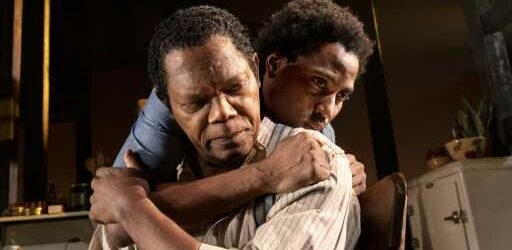Every family has a skeleton or two in its closet. The starry new Broadway revival of August Wilson’s Pulitzer Prize-winning play “The Piano Lesson” has a whole houseful of ghosts.
Director LaTanya Richardson Jackson emphasizes — indeed, embellishes — the spooky parts of the story, which is the fourth chapter (and one of the most popular) in Wilson’s interlocking 10-play series, “The Pittsburgh Cycle.” In this formidable undertaking, Wilson tracks the Black experience across each decade of the 20th century.
In 1936, when “Piano Lesson” is set, the Charles family appears to have survived the worst of the Depression. Doaker Charles (a rock-solid performance from Samuel L. Jackson, who is married to the director), the current patriarch, owns his own home — a true measure of success in this era. A man who adheres to the principle of family stability, he shares this weathered stronghold with his niece, Berniece (an endearing soul, as played by Danielle Brooks) and her young daughter, Maretha (a role played at alternate performances by Jurnee Swan and Nadia Daniel).
Doaker is a pensioned railroad cook whose periodic arias to his treasured profession (“Now, I’ll tell you something about the railroad”) are delivered by Jackson with the rapturous passion of a religious convert. Berniece cleans house for a white family that seems to value her. Even Maretha dutifully does her homework.
A human hurricane blasts through this quiet household when Berniece’s brother, Boy Willie (a whirling dervish of a performance from John David Washington), makes a surprise visit from back home in Sunflower, 1,800 miles away. The truck he rode up on belongs to cousin Lymon (a holy innocent, in Ray Fisher’s appealing performance), although ownership seems to be a wobbly concept in this family.
Boy Willie is on a mission. His plan is to sell the watermelons that he and Lymon trucked up from down home and put the money toward the purchase of a plot of land owned by a white man named Sutter, who has conveniently fallen down a well. Boy Willie vigorously denies any suggestion that he might have had something to do with Sutter’s demise, but a ghostly rumor has it that other property owners have been mysteriously falling down wells lately, too.
The only hitch to Boy Willie’s scheme to buy the land is that in order to raise the full sum, he must sell his share of the family heritage: his mother’s hand-carved piano (and a real beauty), which he jointly owns with his sister. And as everyone keeps telling him: “Berniece ain’t going to sell that piano.”
The spirited battle between brother and sister over the piano is the spine of the plot. But it suggests deeper issues, like the importance of owning property to a striving underclass and the clash of values among individual members of a single family.
The immediate question is whether Berniece’s beautiful upright — a powerful symbol of the family legacy with its hand-carved portraits of so many generations of human heritage — can hold out against Boy Willie’s aspirations of ownership. You’d think that heritage would be a clear win over materialism, but when Washington goes on one of the playwright’s lyrical rants, he’s hard to resist.
Lesser but otherwise entertaining matters keep characters coming and going from Doaker’s house. A newly hatched preacher named Avery (Trai Byers, cute as a baby chick) comes courting Berniece. And Doaker’s gambler brother, Wining Boy (slicker than oil, in Michael Potts’ terrific performance) blows in from Kansas City to illustrate the art of the hustle. Watching him sell a “silk” suit to gullible Lymon is a real piece of work. “I love to ramble,” he says of himself. But when he does sit down, it’s on a piano bench, to pound out some rousing Kansas City jazz.
Wilson clearly loves his characters and gives each one a big solo moment in the spotlight. Even the ghosts of the dead make themselves heard — chiefly Sutter, who manages to spook everyone by chasing bad-boy Willie Boy all the way north to Pittsburgh to plague him. Designers Beowulf Boritt (set), Japhy Weideman (lighting) and Scott Lehrer (sound) have given the dead man a good welcome, and he seems to get along with all the other haunts in the house.
The play’s characters are so individually well-formed and collectively solid that their voices have a way of lingering in the mind, and Wilson’s language is dramatic lyricism of a very high order. When his modest characters speak their minds, they can sound profound. Doaker, the rail-roading man, is only speaking his own truth when he says: “If the train stays on the track, it’s going to get where it’s going.” But when Jackson delivers the line, it sounds positively prophetic. That’s the way it is with Wilson, who speaks for the people, living and dead.
Read More About:
Source: Read Full Article


